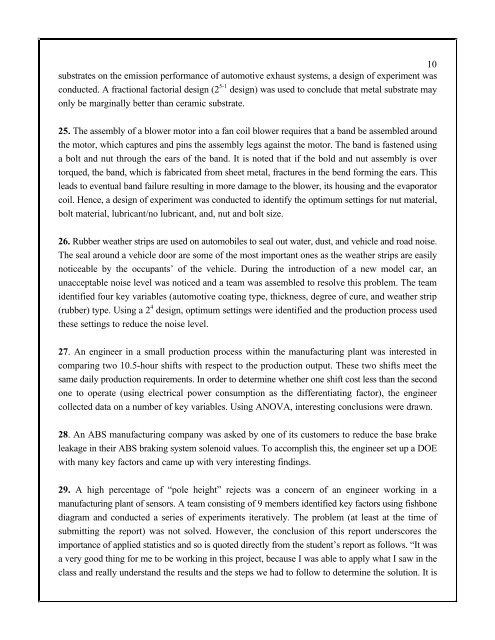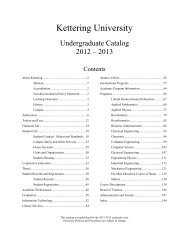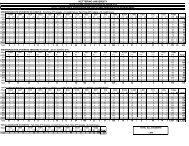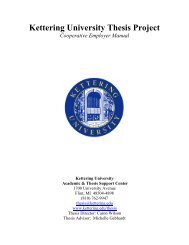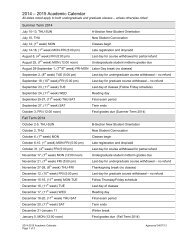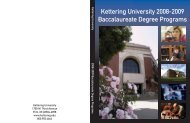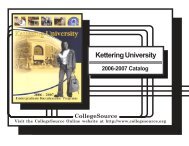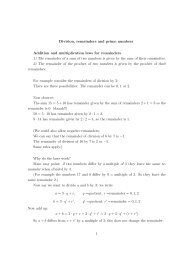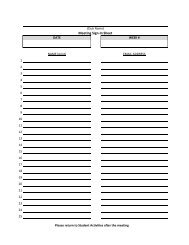1 CLASS LECTURE NOTES - What is Applied Statistics ...
1 CLASS LECTURE NOTES - What is Applied Statistics ...
1 CLASS LECTURE NOTES - What is Applied Statistics ...
Create successful ePaper yourself
Turn your PDF publications into a flip-book with our unique Google optimized e-Paper software.
10<br />
substrates on the em<strong>is</strong>sion performance of automotive exhaust systems, a design of experiment was<br />
conducted. A fractional factorial design (2 5-1 design) was used to conclude that metal substrate may<br />
only be marginally better than ceramic substrate.<br />
25. The assembly of a blower motor into a fan coil blower requires that a band be assembled around<br />
the motor, which captures and pins the assembly legs against the motor. The band <strong>is</strong> fastened using<br />
a bolt and nut through the ears of the band. It <strong>is</strong> noted that if the bold and nut assembly <strong>is</strong> over<br />
torqued, the band, which <strong>is</strong> fabricated from sheet metal, fractures in the bend forming the ears. Th<strong>is</strong><br />
leads to eventual band failure resulting in more damage to the blower, its housing and the evaporator<br />
coil. Hence, a design of experiment was conducted to identify the optimum settings for nut material,<br />
bolt material, lubricant/no lubricant, and, nut and bolt size.<br />
26. Rubber weather strips are used on automobiles to seal out water, dust, and vehicle and road no<strong>is</strong>e.<br />
The seal around a vehicle door are some of the most important ones as the weather strips are easily<br />
noticeable by the occupants’ of the vehicle. During the introduction of a new model car, an<br />
unacceptable no<strong>is</strong>e level was noticed and a team was assembled to resolve th<strong>is</strong> problem. The team<br />
identified four key variables (automotive coating type, thickness, degree of cure, and weather strip<br />
(rubber) type. Using a 2 4 design, optimum settings were identified and the production process used<br />
these settings to reduce the no<strong>is</strong>e level.<br />
27. An engineer in a small production process within the manufacturing plant was interested in<br />
comparing two 10.5-hour shifts with respect to the production output. These two shifts meet the<br />
same daily production requirements. In order to determine whether one shift cost less than the second<br />
one to operate (using electrical power consumption as the differentiating factor), the engineer<br />
collected data on a number of key variables. Using ANOVA, interesting conclusions were drawn.<br />
28. An ABS manufacturing company was asked by one of its customers to reduce the base brake<br />
leakage in their ABS braking system solenoid values. To accompl<strong>is</strong>h th<strong>is</strong>, the engineer set up a DOE<br />
with many key factors and came up with very interesting findings.<br />
29. A high percentage of “pole height” rejects was a concern of an engineer working in a<br />
manufacturing plant of sensors. A team cons<strong>is</strong>ting of 9 members identified key factors using f<strong>is</strong>hbone<br />
diagram and conducted a series of experiments iteratively. The problem (at least at the time of<br />
submitting the report) was not solved. However, the conclusion of th<strong>is</strong> report underscores the<br />
importance of applied stat<strong>is</strong>tics and so <strong>is</strong> quoted directly from the student’s report as follows. “It was<br />
a very good thing for me to be working in th<strong>is</strong> project, because I was able to apply what I saw in the<br />
class and really understand the results and the steps we had to follow to determine the solution. It <strong>is</strong>


